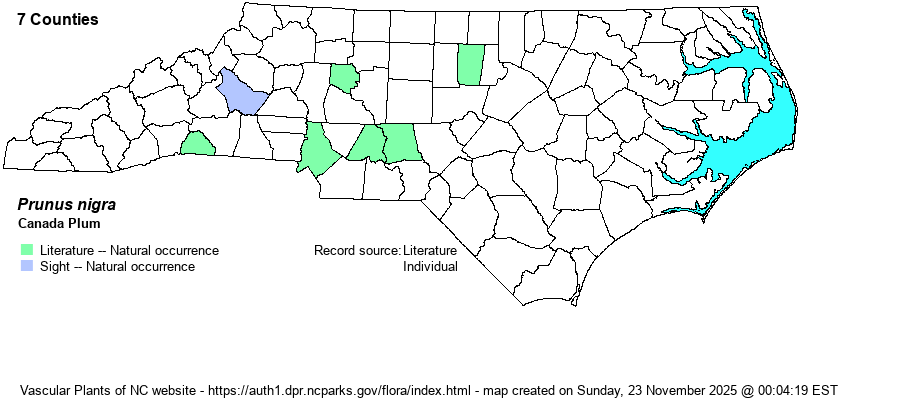| Author | Aiton | |
| Distribution | Reported (correctly?) from a scattering of counties in the central and western Piedmont only, plus two specimens from the Mountains, not mapped, as the website editors are unable to confirm them. However, BONAP and most other references do not show its presence in NC, nor did RAB (1968). However, Weakley (2018) does show records for the NC Piedmont. Though it is a Northern species, it ought to occur in the NC Mountains. The Digital Atlas of the Virginia Flora website shows records for 6 Mountain counties in that state.
As the common name indicates, this species occurs mostly from Canada southward only to NY, OH, and IA; there are scattered records for western VA (which Weakley 2018 indicates with a question mark as of uncertain validity), and presumably some valid records from central NC.
| |
| Abundance | Very rare and poorly known, as most of the reports and specimens are fairly old. A recent report from Burke County indicates that this taxon is still present in the state. This species is currently listed on the Watch List by the NCNHP, but it probably should be tracked as a Significantly Rare species. In fact, their State Rank of S1? is correct if one assumes all of thes handful of records are correct and natural, but the website editors feel that we simply do not know what taxon these reported trees/shrubs truly are and what their provenance is, and thus suggest SU (Undetermined) for now. | |
| Habitat | Over most of its range, it occurs in mesic open woods, woodland borders, stream banks, and other semi-open (if not also semi-disturbed) habitats. Yet, NCNHP says “rich forests”, and the Burke County record is from a rich forested bottomland, over high pH soils. A VA site, along a greenway, is over diabase rock, which has a very high pH. None of the references indicate that, farther north, it is found on high pH soils. |
| Phenology | Blooms mainly in May, before or as leaves emerge, and fruits from June to August. | |
| Identification | This is a small deciduous tree (or rarely a tall shrub), growing mostly to about 15 feet tall. It has a dense crown of stiff branches. Leaves can be identified by their rounded or widely ovate shape and especially by a strongly narrowed/abruptly-contracted tip. The fruit is orange to red and about 1 inch wide. It can be confused or overlooked as an American Plum (P. americana); check references for separation, though the latter grows more in sunny and open situations than does the Canada Plum. | |
| Taxonomic Comments | It seems to never have been split into varieties, and there may well be no alternate scientific names. According to John Townsend, with the VA Division of Natural Heritage, specimens from that state have been suggested to be “not pure” by persons familiar with the species from the core of the range. That should likely apply to NC specimens as well, as NC lies far south of the normal range. The Flora of North America website does not include either state in the range of the species. When referring to the species in the state, the use of "Prunus nigra", in quotes, better represents the truth than simply writing it as Prunus nigra.
| |
| Other Common Name(s) | Canadian Plum, Black Plum | |
| State Rank | S1? [SU] | |
| Global Rank | G5 | |
| State Status | W7 | |
| US Status | | |
| USACE-agcp | | |
| USACE-emp | | |

